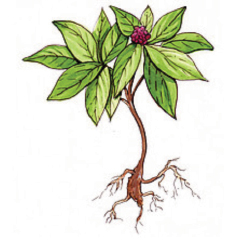The use of dietary supplements by patients with cancer has increased significantly over the past 20 years despite insufficient evidence of safety and effectiveness. Finding reliable sources of information about dietary supplements can be daunting. Patients typically rely on family, friends, and the Internet, often receiving misleading information.
The ASCO Post’s Integrative Oncology series is intended to facilitate the availability of evidence-based information on integrative and complementary therapies commonly used by patients with cancer. We chose American ginseng for this issue because of its increasing use by patients with cancer.
Compiled by Barrie R. Cassileth, PhD, and Jyothirmai Gubili, MS, of Memorial Sloan Kettering Cancer Center. The free About Herbs website is managed by K. Simon Yeung, PharmD, MBA, LAc, of Memorial Sloan Kettering Cancer Center.
American Ginseng
Scientific name: Panax quinquefolius
Common names: Xi yang shen, Tienchi ginseng, western ginseng, five fingers
Overview
A perennial herb with a fleshy root, American ginseng is a native of eastern North America. It was used by Native Americans to treat headaches, fever, indigestion, and infertility. The plant was introduced to China over 300 years ago, where it was prized as a health tonic and continues to be popular today. Both the fresh and dried forms of the root are used in herbal remedies for a variety of ailments. The dried roots of American ginseng are also used in supplemental form to improve athletic performance, strength, and stamina and to treat diabetes and cancer.
Extracts of American ginseng are available in the form of powders, capsules, or liquid tinctures. The whole roots are used to prepare tea. However, quality control is a major issue. Because of the heavy demand for and high price of this herb, adulteration with morphologically similar plants is not uncommon.
American ginseng should not be confused with Panax ginseng or Siberian ginseng, which have different medicinal properties.
The Science
Ginsenosides, the saponin glycosides present in the root and other parts of the plant, have been identified as the active compounds. They have been shown to exert both stimulatory and inhibitory effects on the central nervous system,1 alter cardiovascular tone, enhance humoral and cellular-dependent immunity, and exert anticancer effects in vitro.2
The ginsenoside Rg1 is associated with improvements in humoral and cell-mediated immune response and increases in T helper cells, T lymphocytes, and natural killer cells in mice.3 A metabolite of the ginsenoside Rb1, compound K, was shown to have antiproliferative effects.4
Clinical data suggest that American ginseng may improve glucose control in patients with diabetes5 and that it is safe for long-term use6; has a modest effect in reducing the number and severity of colds7; and enhances working memory in healthy adults8 and in patients with schizophrenia.9
Studies conducted to explore the anticancer potential of American ginseng revealed that its activity was enhanced when combined with antioxidants.10 It had synergistic effects with fluorouracil against colorectal cancer cells11 and conferred protection against oxidative stress in irradiated human lymphocytes.12
Data from an epidemiologic study indicate that American ginseng improved survival and quality of life in patients with breast cancer patients.13 Recent findings from a randomized controlled trial support its benefits in improving cancer-related fatigue.14
Herb-Drug Interactions
Warfarin: American ginseng has been shown to antagonize warfarin’s effects.15
Cytochrome P450 (CYP) 3A4 substrates: Certain ginsenosides can induce CYP3A4 and may affect the metabolism of some drugs that are substrates of this enzyme.16,17
Contraindications
Patients with breast cancer should avoid American ginseng, as it may stimulate the growth of breast cancer cells.18 ■
Disclosure: Ms. Gubili reported no potential conflicts of interest.
References
1. Attele AS, Wu JA, Yuan CS: Ginseng pharmacology: Multiple constituents and multiple actions. Biochem Pharmacol 58:1685-1693, 1999.
2. Xie JT, Du GJ, McEntee E, et al: Effects of triterpenoid glycosides from fresh ginseng berry on SW480 human colorectal cancer cell line. Cancer Res Treat 43:49-55, 2011.
3. Chen SE, Sawchuk RJ, Staba EJ: American ginseng. III: Pharmacokinetics of ginsenosides in the rabbit. Eur J Drug Metab Pharmacokinet 5:161-168, 1980.
4. Wang CZ, Du GJ, Zhang Z, et al: Ginsenoside compound K, not Rb1, possesses potential chemopreventive activities in human colorectal cancer. Int J Oncol 40:1970-1976, 2012.
6. Mucalo I, Jovanovski E, Vuksan V, et al: American ginseng extract (Panax quinquefolius L.) is safe in long-term use in type 2 diabetic patients. Evid Based Complement Alternat Med 2014:969168, 2014.
7. Predy GN, Goel V, Lovlin R, et al: Efficacy of an extract of North American ginseng containing poly-furanosyl-pyranosyl-saccharides for preventing upper respiratory tract infections. CMAJ 173:1043-1048, 2005.
8. Scholey A, Ossoukhova A, Owen L, et al: Effects of American ginseng (Panax quinquefolius) on neurocognitive function: An acute, randomised, double-blind, placebo-controlled, crossover study. Psychopharmacology (Berl) 212:345-356, 2010.
9. Chen EY, Hui CL: HT1001, a proprietary North American ginseng extract, improves working memory in schizophrenia: A double-blind, placebo-controlled study. Phytother Res 26:1166-1172, 2012.
10. Li B, Wang CZ, He TC, et al: Antioxidants potentiate American ginseng-induced killing of colorectal cancer cells. Cancer Lett 289:62-70, 2010.
11. Li XL, Wang CZ, Sun S, et al: American ginseng berry enhances chemopreventive effect of 5-FU on human colorectal cancer cells. Oncol Rep 22:943-952, 2009.
12. Lee TK, O’Brien KF, Wang W, et al: Radioprotective effect of American ginseng on human lymphocytes at 90 minutes postirradiation: A study of 40 cases. J Altern Complement Med 16:561-567, 2010.
13. Cui Y, Shu XO, Gao YT, et al: Association of ginseng use with survival and quality of life among breast cancer patients. Am J Epidemiol 163:645-653, 2006.
14. Barton DL, Liu H, Dakhil SR, et al: Wisconsin ginseng (Panax quinquefolius) to improve cancer-related fatigue: A randomized, double-blind trial, N07C2. J Natl Cancer Inst 105:1230-1238, 2013.
15. Yuan CS, Wei G, Dey L, et al: Brief communication: American ginseng reduces warfarin’s effect in healthy patients: A randomized, controlled trial. Ann Intern Med 141:23-27, 2004.
16. Hao M, Ba Q, Yin J, et al: Deglycosylated ginsenosides are more potent inducers of CYP1A1, CYP1A2 and CYP3A4 expression in HepG2 cells than glycosylated ginsenosides. Drug Metab Pharmacokinet 26:201-205, 2011.
17. Hao M, Zhao Y, Chen P, et al: Structure-activity relationship and substrate-dependent phenomena in effects of ginsenosides on activities of drug-metabolizing P450 enzymes. PLoS One 3:e2697, 2008.
18. Amato P, Christophe S, Mellon PL: Estrogenic activity of herbs commonly used as remedies for menopausal symptoms. Menopause 9:145-150, 2002.
Guest Editor
Integrative Oncology is guest edited by Barrie R. Cassileth, MS, PhD, Chief of the Integrative Medicine Service and Laurance S. Rockefeller Chair in Integrative Medicine at Memorial Sloan Kettering Cancer Center, New York.
The Integrative Medicine Service at Memorial Sloan Kettering Cancer Center developed and maintains a free website—About Herbs (www.mskcc.org/aboutherbs)—that provides objective and unbiased information about herbs, vitamins, minerals, and other dietary supplements, and unproved anticancer treatments. Each of the close to 300 and growing number of entries offers health-care professional and patient versions, and entries are regularly updated with the latest research findings.
In addition, the About Herbs app, Memorial Sloan Kettering Cancer Center’s very first mobile application, can be downloaded at http://itunes.apple.com/us/app/about-herbs/id554267162?mt=8. The app is compatible with iPad, iPhone, and iPod Touch devices.




